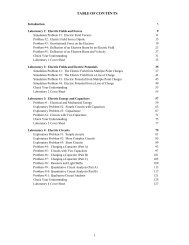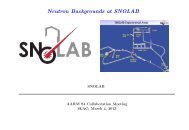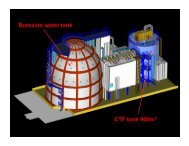Surface Performance of a Big Liquid Scintillation Detector for ...
Surface Performance of a Big Liquid Scintillation Detector for ...
Surface Performance of a Big Liquid Scintillation Detector for ...
Create successful ePaper yourself
Turn your PDF publications into a flip-book with our unique Google optimized e-Paper software.
PMT R4144 <br />
Spectral Response <br />
Backup I: Op:cal proper:es <br />
Figure 4:<br />
CATHODE RADIANT SENSITIVITY (mA/W)<br />
QUANTUM EFFICIENCY (%)<br />
Typical Spectral Response <strong>of</strong> Head-On, Bialkali<br />
Photocathode<br />
100<br />
10<br />
1<br />
0.1<br />
0.01<br />
200<br />
CATHODE<br />
RADIANT<br />
SENSITIVITY<br />
QUANTUM EFFICIENCY<br />
400 600 800<br />
WAVELENGTH (nm)<br />
TPMOB0070EA<br />
PHOTOCATHODE MATERIALS<br />
The photocathode is a photoemissive surface usually consisting<br />
<strong>of</strong> alkali metals with very low work functions. The photocathode<br />
materials most commonly used in photomultiplier tubes<br />
are as follows:<br />
1) Ag-O-Cs<br />
The transmission-mode photocathode using this material<br />
is designated S-1 and sensitive from the visible to infrared<br />
range (300 to 1200nm). EJ 320 Since Ag-O-Cs has comparatively<br />
high thermionic dark emission Paint (refer to "ANODE DARK CUR-<br />
RENT" on page 8), tubes <strong>of</strong> this photocathode are mainly<br />
used <strong>for</strong> detection in the near infrared region with the photocathode<br />
cooled.<br />
6) High temperature bialkali or low noise bialkali<br />
(Na-K-Sb)<br />
This is particularly useful at higher operating temperatures<br />
since it can withstand up to 175°C. A major application<br />
is in the oil well logging industry. At room temperatures, this<br />
photocathode operates with very EJ 301 low dark current, making it<br />
ideal <strong>for</strong> use in photon counting Scin:llator applications. <br />
7) Multialkali (Na-K-Sb-Cs)<br />
The multialkali photocathode has a high, wide spectral response<br />
from the ultraviolet to near infrared region. It is widely<br />
used <strong>for</strong> broad-band spectrophotometers. The long wavelength<br />
response can be extended out to 930nm by special<br />
photocathode processing.<br />
8) Cs-Te, Cs-I<br />
These materials are sensitive to vacuum UV and UV rays<br />
but not to visible light and are there<strong>for</strong>e called solar blind. Cs-<br />
Te is quite insensitive to wavelengths longer than 320nm,<br />
and Cs-I to those longer than 200nm.<br />
WINDOW<br />
Pyrex<br />
MATERIALS<br />
<br />
The window materials commonly used in photomultiplier<br />
tubes are as follows:<br />
1) Borosilicate glass<br />
This is frequently used glass material. It transmits radiation<br />
from the near infrared to approximately 300nm. It is not<br />
suitable <strong>for</strong> detection in the ultraviolet region. For some applications,<br />
the combination <strong>of</strong> a bialkali photocathode and a<br />
low-noise borosilicate glass (so called K-free glass) is used.<br />
The K-free glass contains very low potassium (K2O) which<br />
can cause background counts by 40 K. In particular, tubes designed<br />
<strong>for</strong> scintillation counting <strong>of</strong>ten employ K-free glass not<br />
only <strong>for</strong> the faceplate but also <strong>for</strong> the side bulb to minimize<br />
noise pulses.<br />
16 <br />
16 <br />
2) UV-transmitting glass (UV glass)










